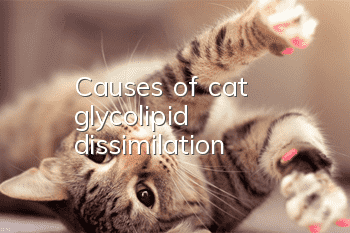Causes of cat glycolipid dissimilation

Cat's glycolipid dissimilation is very similar to glycogen dissimilation. Glucolipids accumulate in lysosomes in a state of incomplete metabolism. The symptoms of the disease vary depending on the enzymes they lack. Cat Glucolipids Lipidosis mostly occurs in purebred cats between two and six months old, and the disease is hereditary. It is recommended that cats with this disease avoid breeding.
1. Reason
1.GM1 gangliosidosis: β-galactosidase deficiency leads to accumulation of GM1 ganglioside in lysosomes, causing damage to neurons.
2. GM2 gangliosidosis (Tay-Sachs disease): Hexopyranosidase A and B deficiency, accumulation of GM2 ganglioside, damage to neurons.
3. Sphingomyelin disease (Niemann-Pick's disease): Due to lack of sphingomyelinase, sphingomyelin accumulates, causing damage to neurons.
4. Phospholipid spheroid leukodystrophy (Krabbe's disease): β-galactocerebrosidase deficiency, accumulation of galactocerebrosid, and damage to macrophages in the white matter.
2. Symptoms
1. It mostly occurs in purebred cats between 2 and 6 months old.
2.GM1 gangliosidosis manifests as movement disorders, head tremors, spastic paralysis of the limbs, etc.
3.GM2 gangliosidosis manifests as abnormal gait, dementia, blindness, convulsive attacks, etc.
4. Sphingomyelin disease manifests as movement disorders, head tremors, etc.
5. Phospholipid spheroid leukodystrophy manifests as hindlimb or limb movement disorders and incomplete paralysis.
6. Other neurological symptoms include loss of reflexes, spinning in place, loss of balance, etc.
7. Hepatosplenomegaly.
8. Gray-white spots appear on the retina or white turbidity of the cornea.
3. Diagnosis
1.GM1 gangliosidosis: Analysis of β-galactosidase deletion in leukocytes or cultured skin fibroblasts.
2.GM2 gangliosidosis: analysis of hexopyranosidase A and B in leukocytes.
3. Sphingomyelinopathy: Analysis of sphingomyelinase in leukocytes, bone marrow or skin fibroblasts.
4. Phospholipid spheroid leukodystrophy: detection of macrophages in cerebrospinal fluid and analysis of β-galactocerebrosidase in leukocytes.
4. Treatment
1. There is no effective treatment.
2. Because this disease can be hereditary, cats suffering from this disease should avoid breeding.
- How much does a snowshoe cat cost? How much does a snowshoe cat cost?
- What are some ways to prevent cats from damaging window cloths and paper?
- What to do if your cat has tooth decay? Solutions to cat tooth decay
- How to correct your cat’s habit of biting his fingers? I’ll teach you how to correct your cat’s bad habit!
- How to treat cirrhosis of Russian Blue cat liver?
- What to do if a Himalayan cat has a fracture
- What are the reasons why Ragdoll cats sneeze?
- What precautions should be taken when raising a cat?
- Does the British Shorthair have a high IQ? How old is the British Shorthair blue cat's IQ equivalent to a human being?
- When can a cat be neutered after giving birth?



